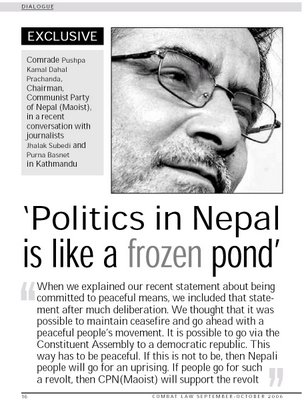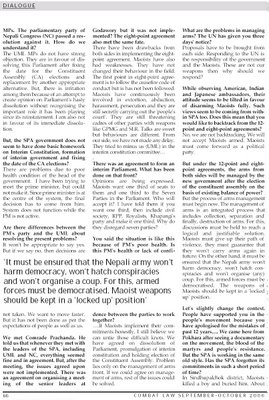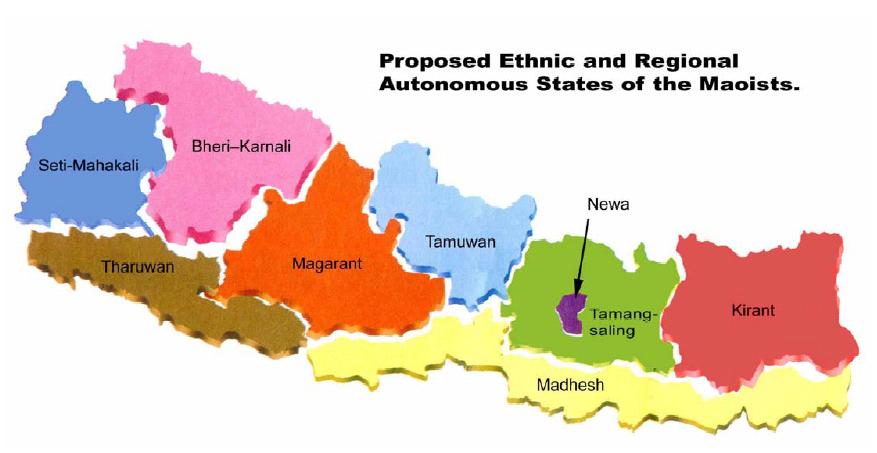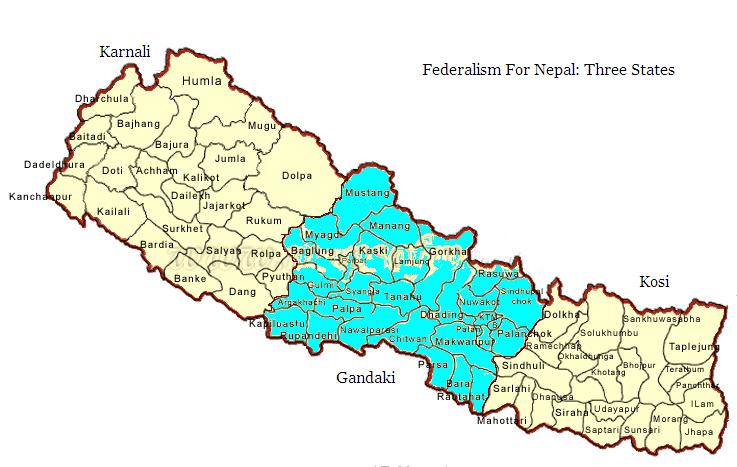











The only full timer out of the 200,000 Nepalis in the US to work for Nepal's democracy and social justice movements in 2005-06.

Will the Maoists of Nepal ever disarm? Financial Express, India After 10 years of a bloody war and with 10,000 cadres killed, why would Maoists settle for a number three slot in Parliament, as opinion polls suggest? Aside from the regular 30,000 odd fighting force of the Maoist army, there are about the 100,000-strong militia which the Maoists have built up in the countryside, an “invisible” force that consists mainly of 14-18 year olds who help enforce the writ of the Maoists.Most of them carry some sort of weapons, ranging from crude knives country pistols, but they do not wear uniforms and do not necessarily take part in military activities. They assist the guerilla only when required and are mostly responsible for guarding villages under Maoist control. They are in effect the future recruits. The presence of this militia has created a pervasive fear in rural areas, and many experts see a parallel between current-day Nepal and Cambodia during the post-1979 period.It is not possible to imagine free and fair elections to a constituent assembly if there are any armed Maoists anywhere outside their seven cantonments. I don't care if you call them soldiers or militia. To me they are both the same. Both are armed.

The current "zones" and "development regions" are to be abolished, but the "districts" are to be retained. The country is to be divided into three states, roughly of equal population, Eastern, Central, and Western, to be called Koshi, Gandaki, and Karnali, that are to include all three geographical regions, Terai, Pahad and Himal, and based on the three river basins. Each state is to have a Pratinidhi Sabha, 120 members, and a Rajya Sabha, 40 members. Each seat for the federal Pratinidhi Sabha is to be divided into two for the state Pratinidhi Sabha ............ The federal government will directly transfer 10% of its annual budget to the 25 poorest districts measured by per capita income. This does not prevent further federal expenditures on those districts. .......... The income tax structure is to be as follows: 50% federal, 30% state, 10% district, and 10% village/town/city. The income tax is to be collected by the federal government, and funds transferred by the same to the other levels of government as per this formula, and is to be gradually phased in where none might be getting collected now. ......... The federal revenue from all sources other than income tax is also to be similarly allocated. 50% stays at the federal level, the rest goes to the three states equally. Each state is also to send out 40% of its non income tax budget directly to the districts in direct proportion to the population of each district.
(Source: Proposed Constitution)

 I have been consistently vocal on Madhesi rights. I have been so vocal, it has earned me a place in the Madhesi Hall Of Fame. I have been put in the same league as people like Gajendra Narayan Singh, Ram Raja Prasad Singh, Udit Narayan Jha, Upendra Mahato, among others.
I have been consistently vocal on Madhesi rights. I have been so vocal, it has earned me a place in the Madhesi Hall Of Fame. I have been put in the same league as people like Gajendra Narayan Singh, Ram Raja Prasad Singh, Udit Narayan Jha, Upendra Mahato, among others.
DALIT DIASPORA CALLS FOR 20 PERCENT DALIT REPRESENTATION IN NEW NEPAL GOVERNMENT
September 1, 2006, Washington, DC: Dalit advocates from among the Nepali diaspora in the United States have criticized Nepal's draft interim constitution because it does not endorse affirmative action on behalf of Dalit.
The criticism has been leveled by the Nepali-American Society for Oppressed Community (NASO) against the Interim Constitutional Drafting Committee, which presented its proposals to the Nepali government and Maoists on August 25.
NASO had earlier sent an open letter to the Committee demanding that Dalit be guaranteed 20 percent of the positions in the government and in all state bodies, proportionate to the Dalit population in Nepal.
The proposal was ignored by the Committee, which declined even to respond to the NASO letter. The Committee's draft makes no specific provision to include Dalit in political life.
Contacted by the Advocacy Project (AP), Prakash Nepal from NASO said that in the absence of special provisions, Dalit will almost certainly not be elected to the Constitutional Assembly when elections are held next April, or in subsequent parliamentary elections, because Dalit do not hold a majority in any region of the country. Mr. Nepal told AP that NASO will now lobby hard with the US Congress to push for quotas before the Assembly elections.
NASO has also called on aid agencies to allocate 20 percent of their budgets for Nepal to Dalit. Mr. Prakash said that the goal is to "eliminate the gap between the lower and upper castes," adding that this should be seen as a temporary measure that would last until a "casteless society" is created in Nepal.
The reaction of some aid agencies has been positive. Dr. Prasen Jit Khati, the policy and advocacy advisor for Oxfam in Nepal, said that all of Oxfam's programs focus on gender and social inclusion and agreed that aid should go to the most "marginalized Dalit." Even a 20 percent quota was "not enough," he said.
An official from ActionAid said that the agency's program in Nepal centers around 10 minority groups. While Dalit receive roughly 14 percent, he said, the agency might agree to increase this to 20 percent.
But an official from the World Bank told AP that the Bank is opposed to such affirmative action because it does not want to "reward" certain groups over others. An official at UNICEF also expressed concern that a 20 percent quota would discriminate against other needy sectors of the population that do not have the Dalit contacts or ability to lobby.
While the Dalit population in North America is small "estimated in the hundreds" NASO's members are influential in the Nepali diaspora. NASO also has considerable lobbying power, given its proximity to the US Congress and multilateral organizations.
Meanwhile, in another sign of the internationalization of Dalit advocacy, Pratik Pande, from the Jagaran Media Center (JMC), recently told the UN Working Group on Minorities in Geneva that the government of Nepal must ensure proportional representation for Dalit and other minorities in the new democratic Nepal.
This was first time that JMC, a partner of AP, had addressed the UN directly. JMC is also pressing the UN Development Program to use its aid to ensure that Dalit do not face discrimination at water taps in western Nepal.
Two AP interns Nicole Cordeau and Stacey Spivey have been working with JMC this summer, and another AP intern Lori Tomoe Mizuno is working with the Collective Campaign for Peace (COCAP) in Kathmandu. One of their tasks has been to collect information, which can be disseminated by AP and used by advocates like NASO outside the country.
Dalits and the Interim Constitution
A letter from the Nepali-American Society for Oppressed Community
(NASO) to the Interim Constitution Drafting Committee (ICDC)
On behalf of the Nepalese and well-wishers of Nepal living in North America, we appreciate you and your team for undertaking one of the most important and challenging tasks of developing the Interim Constitution of Nepal 2006. As aspired to by the people’s revolution, every citizen is in great hope that the Interim Constitution would lead Nepal towards a total pluralistic, inclusive and democratic nation.
There is no need to elaborate that the country now is at a critical time in its history. We have many challenges and constraints ahead but also have tremendous opportunities to change our nation forever. Any lack or negligence in taking appropriate actions can cost the country high in the long run.
Inclusive governance with total protection of human rights to every citizen of the country is undoubtedly the pre-condition for peace and sustainable development. Unfortunately, for Dalits, this has never been the case, which caused them to be socially, economically and politically excluded for a long time in the history of Nepal. This must be addressed now and the necessary steps must be taken in the Interim Constitution. The Interim Constitution must explicitly state provisions to protect Dalit men, women and children, their right to live in dignity, with empowerment and without fear. We believe that your august committee will do every effort to ensure protection to Dalits in particular.
However, in order to ensure that no opportunity is missed to address the problems faced by Dalits this time, unlike the past, we urge you to include among many provisions particularly the following provisions into the interim constitution. We strongly believe, and hope that you would pay particular attention to the fact that until and unless the socio-economic and cultural discriminations against Dalits are eradicated, Nepal can never achieve peace and prosperity. The following provisions, if clearly stated in the Interim Constitution, will mount a foundation that will facilitate the rights, dignity, and advancement of Dalits; and thus ensure a peaceful and prosperous future Nepal.
Therefore, we specifically demand the Interim Constitution to:
NASO to the ICDC
| 25 August 2006, Friday | 225 | |
| 26 August 2006, Saturday | 216 | |
| 27 August 2006, Sunday | 242 | |
| 28 August 2006, Monday | 177 | |
| 29 August 2006, Tuesday | 167 | |
| 30 August 2006, Wednesday | 210 | |
| 31 August 2006, Thursday | 161 |
| 14:47 | University of Southern Colorado, Pueblo, United States |
| 15:28 | Mahanagar Telephone Nigam, India |
| 16:13 | Comcast Communications, Royal Oak, United States |
| 16:58 | Ono.es Cableuropa S.A.U., Spain |
| 16:58 | Avaya Corp., United States |
| 18:11 | Wanadoo Nederland BV, Netherlands, The |
| 20:20 | University of Medicine and Dentistry of New Jersey, United States |
| 20:56 | Taiwan Academic Network, Taiwan |


